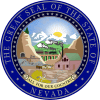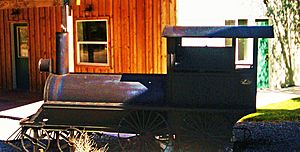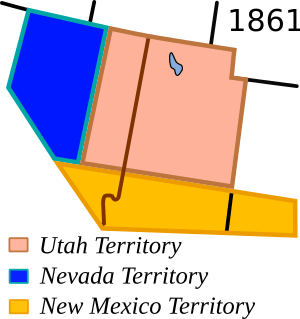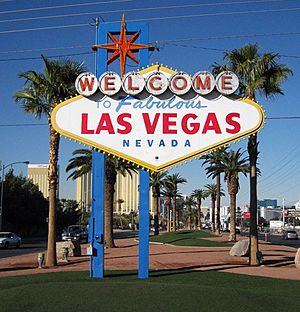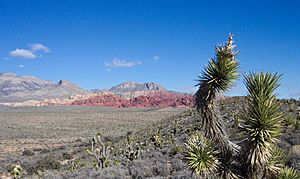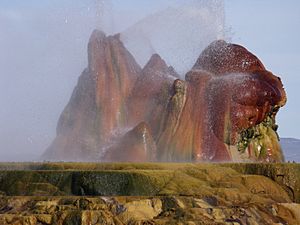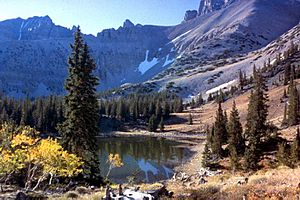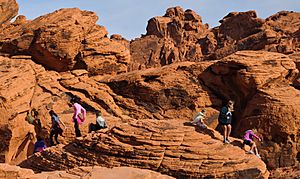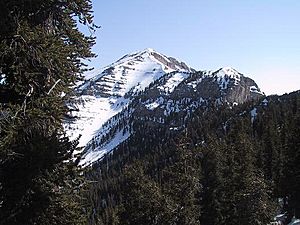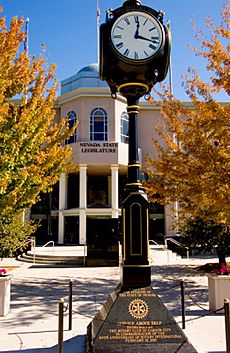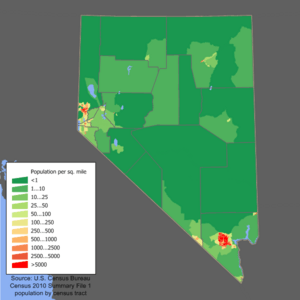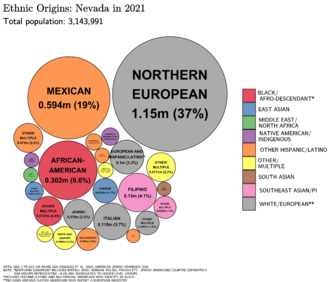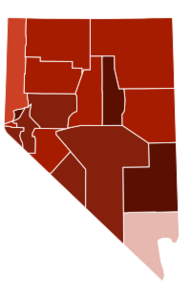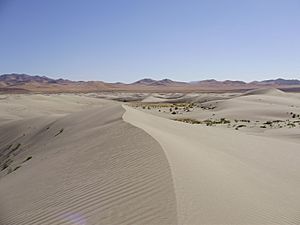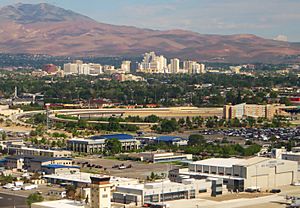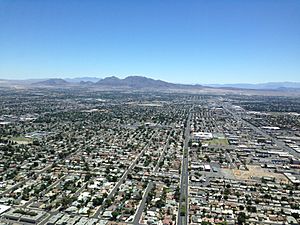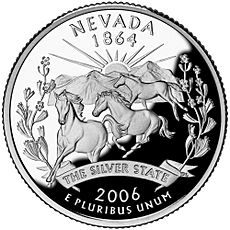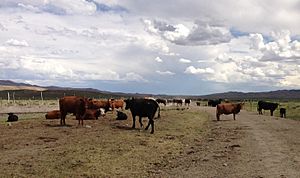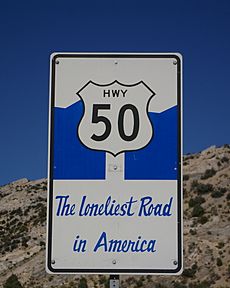Nevada facts for kids
Quick facts for kids
Nevada
|
|||
|---|---|---|---|
|
|||
| Nickname(s):
The Silver State (official);
The Sagebrush State; The Battle Born State |
|||
| Motto(s):
All for Our Country
|
|||
| Anthem: "Home Means Nevada" |
|||
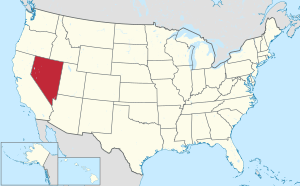
Location of Nevada within the United States
|
|||
| Country | United States | ||
| Before statehood | Nevada Territory, Utah Territory, Arizona Territory | ||
| Admitted to the Union | October 31, 1864 (36th) | ||
| Capital | Carson City | ||
| Largest city | Las Vegas | ||
| Largest county or equivalent | Clark | ||
| Largest metro and urban areas | Las Vegas Valley | ||
| Legislature | Nevada Legislature | ||
| • Upper house | Senate | ||
| • Lower house | Assembly | ||
| Judiciary | Supreme Court of Nevada | ||
| U.S. senators | Catherine Cortez Masto (D) Jacky Rosen (D) |
||
| U.S. House delegation | 3 Democrats 1 Republican (list) |
||
| Area | |||
| • Total | 110,577 sq mi (286,382 km2) | ||
| • Land | 109,781.18 sq mi (284,332 km2) | ||
| • Water | 791 sq mi (2,048 km2) 0.72% | ||
| Area rank | 7th | ||
| Dimensions | |||
| • Length | 492 mi (787 km) | ||
| • Width | 322 mi (519 km) | ||
| Elevation | 5,500 ft (1,680 m) | ||
| Highest elevation | 13,147 ft (4,007.1 m) | ||
| Lowest elevation
(Colorado River at California border)
|
481 ft (147 m) | ||
| Population
(2024)
|
|||
| • Total | |||
| • Rank | 31st | ||
| • Density | 26.8/sq mi (10.3/km2) | ||
| • Density rank | 42nd | ||
| • Median household income | $76,400 (2023) | ||
| • Income rank | 24th | ||
| Demonym(s) | Nevadan | ||
| Language | |||
| • Official language | None | ||
| Time zones | |||
| most of state | UTC−08:00 (Pacific) | ||
| • Summer (DST) | UTC−07:00 (PDT) | ||
| West Wendover | UTC−07:00 (Mountain) | ||
| • Summer (DST) | UTC−06:00 (MDT) | ||
| USPS abbreviation |
NV
|
||
| ISO 3166 code | US-NV | ||
| Traditional abbreviation | Nev. | ||
| Latitude | 35° N to 42° N | ||
| Longitude | 114° 2′ W to 120° W | ||
| Song | Home Means Nevada |
|---|---|
| Bird | Mountain bluebird (Sialia currucoides) |
| Fish | Lahontan cutthroat trout (Oncorhynchus clarkii henshawi) |
| Flower | Sagebrush (Artemisia tridentata) |
| Tree | Bristlecone pine, Single-leaf Piñon (Pinus monophylla) |
| Insect | Vivid Dancer Damselfly (Argia vivida) |
Nevada ( nə-VAD-ə-,_---VAH--) is a landlocked state in the Western region of the United States. It borders Oregon to the northwest, Idaho to the northeast, California to the west, Arizona to the southeast, and Utah to the east. Nevada is the seventh-most extensive, the 32nd-most populous, and the ninth-least densely populated U.S. state. Nearly three-quarters of Nevada's population live in Clark County, which contains the Las Vegas–Paradise metropolitan area, including three of the state's four largest incorporated cities. Nevada's capital is Carson City. Las Vegas is the largest city in the state.
Nevada is officially known as the "Silver State" because of the importance of silver to its history and economy. It is also known as the "Battle Born State" because it achieved statehood during the Civil War (the words "Battle Born" also appear on its state flag); due to the presidency of Abraham Lincoln, the Union benefited immensely from the support of newly awarded statehood by the infusion of the monetary support of nearly $400 million in silver ore generated at the time by the Comstock Lode. It is also known as the "Sagebrush State", for the native plant of the same name; and as the "Sage-hen State". The state's name means "snowy" in Spanish, referring to Nevada's small overlap with the Sierra Nevada mountain range; however, the rest of Nevada is largely desert and semi-arid, much of it within the Great Basin. Areas south of the Great Basin are within the Mojave Desert, while Lake Tahoe and the Sierra Nevada lie on the western edge. In 2020, 80.1% of the state's land was managed by various jurisdictions of the U.S. federal government, both civilian and military.
Native Americans of the Paiute, Shoshone, and Washoe tribes inhabit what is now Nevada. The first Europeans to explore the region were Spanish. They called the region Nevada (snowy) because of the snow which covered the mountains in winter, similar to the Sierra Nevada in Spain. The area formed from mostly Alta California and part of Nuevo México's territory within the Viceroyalty of New Spain, which gained independence as Mexico in 1821. The United States annexed the area in 1848 after its victory in the Mexican–American War, and it was incorporated as part of the New Mexico and Utah Territory in 1850. The discovery of silver at the Comstock Lode in 1859 led to a population boom that became an impetus to the creation of Nevada Territory out of western Utah Territory in 1861. Nevada became the 36th state on October 31, 1864, as the second of two states added to the Union during the Civil War (the first being West Virginia).
The tourism industry remains Nevada's largest employer, with mining continuing as a substantial sector of the economy: Nevada is the fourth-largest producer of gold in the world. Nevada is the driest state, and over time, and influenced by climate change, droughts in Nevada have been increasing in frequency and severity, putting a further strain on Nevada's water security.
Contents
Etymology
The name "Nevada" comes from the Spanish adjective nevada ([neˈβaða]), meaning "snow-covered" or "snowy". The state takes its name from the Nevada Territory, which in turn was named for the Sierra Nevada.
Nevadans pronounce the second syllable with the "a" of "apple" (/nəˈvædə/) while some people from outside of the state pronounce it with the "a" of "palm" (/nəˈvɑːdə/). Although the quality, but not the length, of the latter pronunciation is closer to the Spanish pronunciation (Spanish /a/ is open central [ä], whereas American English /ɑː/ varies from back [ɑː] to central [äː]), it is not the pronunciation used by Nevadans. State Assemblyman Harry Mortenson proposed a bill to recognize the alternative pronunciation of Nevada, though the bill was not supported by most legislators and never received a vote. The Nevadan pronunciation is the one used by the state legislature. At one time, the state's official tourism organization, TravelNevada, stylized the name of the state as "Nevăda", with a breve over the a indicating the locally preferred pronunciation, which was also available as a license plate design until 2007.
History
Before 1861
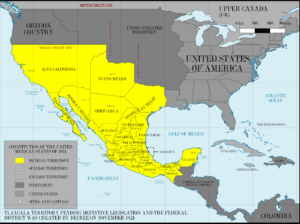
Francisco Garcés was the first European in the area, Nevada was annexed as a part of the Spanish Empire in the northwestern territory of New Spain.
Administratively, the area of Nevada was part of the Commandancy General of the Provincias Internas in the Viceroyalty of New Spain. Nevada became a part of Alta California (Upper California) province in 1804 when the Californias were split.
With the Mexican War of Independence won in 1821, the province of Alta California became a territory (state) of Mexico, with small population.
Jedediah Smith entered the Las Vegas Valley in 1827, and Peter Skene Ogden traveled the Humboldt River in 1828. When the Mormons created the State of Deseret in 1847, they laid claim to all of Nevada within the Great Basin and the Colorado watershed. In June 1855, William Bringhurst and 29 fellow Mormon missionaries from Utah arrived at this site just northeast of downtown Las Vegas and built a 150-foot square adobe fort, the first permanent structure erected in the valley, which remained under the control of Salt Lake City until the winter of 1858-1859.
As a result of the Mexican–American War and the Treaty of Guadalupe-Hidalgo, Mexico permanently lost Alta California in 1848. The new areas acquired by the United States continued to be administered as territories.
As part of the Mexican Cession (1848) and the subsequent California Gold Rush that used Emigrant Trails through the area, the state's area evolved first as part of the Utah Territory, then the Nevada Territory (March 2, 1861; named for the Sierra Nevada).
See History of Utah, History of Las Vegas, and the discovery of the first major U.S. deposit of silver ore in Comstock Lode under Virginia City, Nevada in 1859.
Separation from Utah Territory
On March 2, 1861, the Nevada Territory separated from the Utah Territory and adopted its current name, shortened from Sierra Nevada (Spanish for "snow-covered mountain range").
The 1861 southern boundary is commemorated by Nevada Historical Markers 57 and 58 in Lincoln and Nye counties.
Statehood (1864)
Eight days before the presidential election of 1864, Nevada became the 36th state in the union. Statehood was rushed to the date of October 31 to help ensure Abraham Lincoln's reelection on November 8 and post-Civil War Republican dominance in Congress, as Nevada's mining-based economy tied it to the more industrialized Union. As it turned out, however, Lincoln and the Republicans won the election handily, and did not need Nevada's help.
Nevada is one of only two states to significantly expand its borders after admission to the Union. (The other is Missouri, which acquired additional territory in 1837 due to the Platte Purchase.)
In 1866 another part of the western Utah Territory was added to Nevada in the eastern part of the state, setting the current eastern boundary.
Nevada achieved its current southern boundaries on January 18, 1867, when it absorbed the portion of Pah-Ute County in the Arizona Territory west of the Colorado River, essentially all of present-day Nevada south of the 37th parallel. The transfer was prompted by the discovery of gold in the area, and it was thought by officials that Nevada would be better able to oversee the expected population boom. This area includes most of what is now Clark County and the Las Vegas metropolitan area.
Mining shaped Nevada's economy for many years. When Mark Twain lived in Nevada during the period described in Roughing It, mining had led to an industry of speculation and immense wealth. However, both mining and population declined in the late 19th century. However, the rich silver strike at Tonopah in 1900, followed by strikes in Goldfield and Rhyolite, again put Nevada's population on an upward trend.
Gambling and labor
Unregulated gambling was commonplace in the early Nevada mining towns but was outlawed in 1909 as part of a nationwide anti-gambling crusade. Because of subsequent declines in mining output and the decline of the agricultural sector during the Great Depression, Nevada again legalized gambling on March 19, 1931, with approval from the legislature. Governor Fred B. Balzar's signature enacted the most liberal divorce laws in the country and open gambling. The reforms came just eight days after the federal government presented the $49 million construction contract for Boulder Dam (now Hoover Dam).
Nuclear testing
The Nevada Test Site, 65 miles (105 km) northwest of the city of Las Vegas, was founded on January 11, 1951, for the testing of nuclear weapons. The site consists of about 1,350 square miles (3,500 km2) of desert and mountainous terrain. Nuclear testing at the Nevada Test Site began with a 1 kiloton of TNT (4.2 TJ) bomb dropped on Frenchman Flat on January 27, 1951. The last atmospheric test was conducted on July 17, 1962, and the underground testing of weapons continued until September 23, 1992. The location is known for having the highest concentration of nuclear-detonated weapons in the U.S.
Over 80% of the state's area is owned by the federal government. The primary reason for this is that homesteads were not permitted in large enough sizes to be viable in the arid conditions that prevail throughout desert Nevada. Instead, early settlers would homestead land surrounding a water source, and then graze livestock on the adjacent public land, which is useless for agriculture without access to water (this pattern of ranching still prevails).
Geography
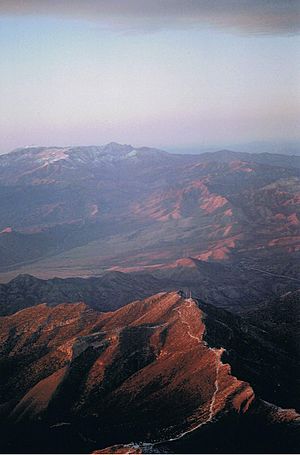
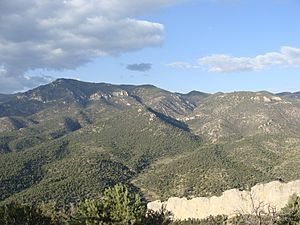
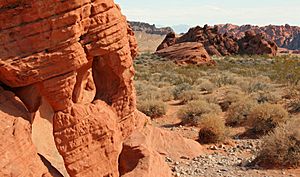
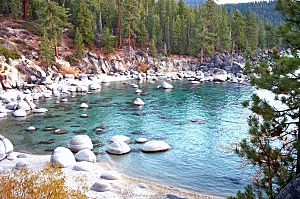
Nevada is almost entirely within the Basin and Range Province, and is broken up by many north-south mountain ranges. Most of these ranges have endorheic valleys between them, which belies the image portrayed by the term Great Basin.
Much of the northern part of the state is within the Great Basin, a mild desert that experiences hot temperatures in the summer and cold temperatures in the winter. Occasionally, moisture from the Arizona Monsoon will cause summer thunderstorms; Pacific storms may blanket the area with snow.
The Humboldt River crosses the state from east to west across the northern part of the state, draining into the Humboldt Sink near Lovelock. Several rivers drain from the Sierra Nevada eastward, including the Walker, Truckee, and Carson rivers. All of these rivers are endorheic basins, ending in Walker Lake, Pyramid Lake, and the Carson Sink, respectively. However, not all of Nevada is within the Great Basin. Tributaries of the Snake River drain the far north, while the Colorado River, which also forms much of the boundary with Arizona, drains much of southern Nevada.
The mountain ranges, some of which have peaks above 13,000 feet (4,000 m), harbor lush forests high above desert plains, creating sky islands for endemic species. The valleys are often no lower in elevation than 3,000 feet (910 m), while some in central Nevada are above 6,000 feet (1,800 m).
The southern third of the state, where the Las Vegas area is situated, is within the Mojave Desert. The area receives less rain in the winter but is closer to the Arizona Monsoon in the summer. The terrain is also lower, mostly below 4,000 feet (1,200 m), creating conditions for hot summer days and cool to chilly winter nights (the result of temperature inversion).
Nevada and California have by far the longest diagonal line (in respect to the cardinal directions) as a state boundary at just over 400 miles (640 km). This line begins in Lake Tahoe nearly 4 miles (6.4 km) offshore (in the direction of the boundary), and continues to the Colorado River where the Nevada, California, and Arizona boundaries merge 12 miles (19 km) southwest of the Laughlin Bridge.
The largest mountain range in the southern portion of the state is the Spring Mountain Range, just west of Las Vegas. The state's lowest point is along the Colorado River, south of Laughlin.
Nevada has 172 mountain summits with 2,000 feet (610 m) of prominence. Nevada ranks second in the USA, behind Alaska, and ahead of California, Montana, and Washington. Nevada is the most mountainous state in the contiguous United States.
Climate
Nevada is the driest state in the United States. It is made up of mostly desert and semi-arid climate regions, and, with the exception of the Las Vegas Valley, the average summer diurnal temperature range approaches 40 °F (22 °C) in much of the state.
While winters in northern Nevada are long and fairly cold, the winter season in the southern part of the state tends to be of short duration and mild. Most parts of Nevada receive scarce precipitation during the year. Most rain that falls in the state falls on the lee side (east and northeast slopes) of the Sierra Nevada.
Vegetation
The vegetation of Nevada is diverse and differs by state area. Nevada contains six biotic zones: alpine, sub-alpine, ponderosa pine, pinion-juniper, sagebrush and creosotebush.
Parks and recreation areas
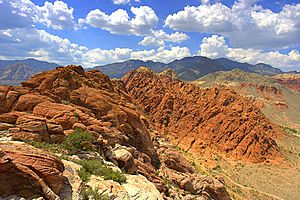

Wilderness
There are 68 designated wilderness areas in Nevada, protecting some 6,579,014 acres (2,662,433 ha) under the jurisdiction of the National Park Service, U.S. Forest Service, and Bureau of Land Management.
State parks
The Nevada state parks comprise protected areas managed by the state of Nevada, including state parks, state historic sites, and state recreation areas. There are 24 state park units, including Van Sickle Bi-State Park which opened in July 2011 and is operated in partnership with the state of California.
Government
Under the Constitution of the State of Nevada, the powers of the Nevada government are divided among three separate departments: the executive consisting of the governor of Nevada and their cabinet along with the other elected constitutional officers; the legislative consisting of the Nevada Legislature, which includes the Assembly and the Senate; and the judicial consisting of the Supreme Court of Nevada and lower courts.
The governor is the chief magistrate of Nevada, the head of the executive department of the state's government, and the commander-in-chief of the state's military forces. The executive branch also consists of an independently elected lieutenant governor, secretary of state, state treasurer, state controller, and attorney general who function as a check and balance on the power of the governor.
The Nevada Legislature is a bicameral body divided into an Assembly and Senate. Members of the Assembly serve two years, and members of the Senate serve four years. Both houses of the Nevada Legislature enacted term limits starting in 2010, with senators and assemblymen/women who are limited to a maximum of twelve years in each body (by appointment or election which is a lifetime limit) – a provision of the constitution which was upheld by the Supreme Court of Nevada in a unanimous decision. Each session of the legislature meets for a constitutionally mandated 120 days in every odd-numbered year, or longer if the governor calls a special session.
On December 18, 2018, Nevada became the first in the United States with a female majority in its legislature. Women hold nine of the 21 seats in the Nevada Senate, and 23 of the 42 seats in the Nevada Assembly.
The Supreme Court of Nevada is the state supreme court and the head of the Nevada Judiciary. Original jurisdiction is divided between the district courts (with general jurisdiction), and justice courts and municipal courts (both of limited jurisdiction). Appeals from District Courts are made directly to the Nevada Supreme Court, which under a deflective model of jurisdiction, has the discretion to send cases to the Court of Appeals for final resolution.
Incorporated towns in Nevada, known as cities, are given the authority to legislate anything not prohibited by law. A recent movement has begun to permit home rule to incorporate Nevada cities to give them more flexibility and fewer restrictions from the Legislature. Town Boards for unincorporated towns are limited local governments created by either the local county commission, or by referendum, and form a purely advisory role and in no way diminish the responsibilities of the county commission that creates them.
Demographics
Population
| Historical population | |||
|---|---|---|---|
| Census | Pop. | %± | |
| 1860 | 6,857 | — | |
| 1870 | 42,941 | 526.2% | |
| 1880 | 62,266 | 45.0% | |
| 1890 | 47,355 | −23.9% | |
| 1900 | 42,335 | −10.6% | |
| 1910 | 81,875 | 93.4% | |
| 1920 | 77,407 | −5.5% | |
| 1930 | 91,058 | 17.6% | |
| 1940 | 110,247 | 21.1% | |
| 1950 | 160,083 | 45.2% | |
| 1960 | 285,278 | 78.2% | |
| 1970 | 488,738 | 71.3% | |
| 1980 | 800,493 | 63.8% | |
| 1990 | 1,201,833 | 50.1% | |
| 2000 | 1,998,257 | 66.3% | |
| 2010 | 2,700,551 | 35.1% | |
| 2020 | 3,104,614 | 15.0% | |
| 2023 (est.) | 3,194,176 | 18.3% | |
| Source: 1910–2020 | |||
The United States Census Bureau determined Nevada had a population of 3,104,614 at the 2020 U.S. census. In 2022, the estimated population of Nevada was 3,177,772, an increase of 73,158 residents (2.36%) since the 2020 census. Nevada had the highest percentage growth in population from 2017 to 2018. At the 2020 census, 6.0% of the state's population were reported as under 5, 22.5% were under 18, and 16.1% were 65 or older. Females made up about 49.8% of the population. 19.1% of the population was reported as foreign-born.
Since the 2020 census, the population of Nevada had a natural increase of 2,374 (the net difference between 42,076 births and 39,702 deaths); and an increase due to net migration of 36,605 (of which 34,280 was due to domestic and 2,325 was due to international migration).
The center of population of Nevada is in southern Nye County. In this county, the unincorporated town of Pahrump, 60 miles (97 km) west of Las Vegas on the California state line, has grown very rapidly from 1980 to 2020. At the 2020 census, the town had 44,738 residents. Las Vegas grew from a gulch of 100 people in 1900 to 10,000 by 1950 to 100,000 by 1970, and was America's fastest-growing city and metropolitan area from 1960 to 2000.
From about the 1940s until 2003, Nevada was the fastest-growing state in the U.S. percentage-wise. Between 1990 and 2000, Nevada's population increased by 66%, while the nation's population increased by 13%. More than two-thirds of the population live in Clark County, which is coextensive with the Las Vegas metropolitan area. Thus, in terms of population, Nevada is one of the most centralized states in the nation.
Henderson and North Las Vegas are among the top 20 fastest-growing U.S. cities with populations over 100,000. The rural community of Mesquite 65 miles (105 km) northeast of Las Vegas was an example of micropolitan growth in the 1990s and 2000s. Other desert towns like Indian Springs and Searchlight on the outskirts of Las Vegas have seen some growth as well.
Since 1950, the rate of population born in Nevada has never peaked above 27 percent, the lowest rate of all states. In 2012, only 25% of Nevadans were born in Nevada.
According to HUD's 2022 Annual Homeless Assessment Report, there were an estimated 7,618 homeless people in Nevada.
Race and ethnicity
| Race / Ethnicity | Pop 2000 | Pop 2010 | Pop 2020 | % 2000 | % 2010 | % 2020 |
|---|---|---|---|---|---|---|
| White alone (NH) | 1,303,001 | 1,462,081 | 1,425,952 | 65.21% | 54.14% | 45.93% |
| Black or African American alone (NH) | 131,509 | 208,058 | 291,960 | 6.58% | 7.70% | 9.40% |
| Native American or Alaska Native alone (NH) | 21,397 | 23,536 | 23,392 | 1.07% | 0.87% | 0.75% |
| Asian alone (NH) | 88,593 | 191,047 | 265,991 | 4.43% | 7.07% | 8.57% |
| Pacific Islander alone (NH) | 7,769 | 15,456 | 22,970 | 0.39% | 0.57% | 0.74% |
| Some Other Race alone (NH) | 2,787 | 4,740 | 17,171 | 0.14% | 0.18% | 0.55% |
| Mixed Race/Multi-Racial (NH) | 49,231 | 79,132 | 166,921 | 2.46% | 2.93% | 5.38% |
| Hispanic or Latino (any race) | 393,970 | 716,501 | 890,257 | 19.72% | 26.53% | 28.68% |
| Total | 1,998,257 | 2,700,551 | 3,104,614 | 100.00% | 100.00% | 100.00% |
| Race and Ethnicity | Alone | Total | ||
|---|---|---|---|---|
| White (non-Hispanic) | 45.9% |
|
50.6% |
|
| Hispanic or Latino | — | 28.7% |
|
|
| Multiracial | — | 14.0% |
|
|
| African American (non-Hispanic) | 9.4% |
|
11.1% |
|
| Asian | 8.6% |
|
10.7% |
|
| Native American | 0.8% |
|
2.1% |
|
| Pacific Islander | 0.7% |
|
1.5% |
|
| Other | 0.6% |
|
1.4% |
|
According to the 2022 American Community Survey, 30.3% of Nevada's population were of Hispanic or Latino origin (of any race): Mexican (22%), Cuban (1.5%), Salvadoran (1.5%), Puerto Rican (1%), and other Hispanic or Latino origin (4.3%). The largest European ancestry groups were: German (8.9%), English (8.1%), Irish (7.2%), and Italian (4.8%). The largest Asian ancestry groups in the state were Filipino (6.4%) and Chinese (1.9%).
In 1980, non-Hispanic whites made up 83.2% of the state's population.
| Racial composition | 1970 | 1980 | 1990 | 2000 | 2010 | 2020 |
|---|---|---|---|---|---|---|
| White | 91.7% | 87.5% | 84.3% | 75.2% | 66.2% | 51.2% |
| Black | 5.7% | 6.4% | 6.6% | 6.8% | 8.1% | 9.8% |
| Asian | 0.7% | 1.8% | 3.2% | 4.5% | 7.2% | 8.8% |
| Native | 1.6% | 1.7% | 1.6% | 1.3% | 1.2% | 1.4% |
| Native Hawaiian and other Pacific Islander |
– | – | – | 0.4% | 0.6% | 0.8% |
| Other race | 0.3% | 2.7% | 4.4% | 8.0% | 12.0% | 14.0% |
| Two or more races | – | – | – | 3.8% | 4.7% | 14.0% |
| Hispanic or Latino (of any race) | 5.6% | 6.7% | 10.4% | 19.7% | 26.5% | 28.7% |
| Non-Hispanic white | 86.7% | 83.2% | 78.7% | 65.2% | 54.1% | 45.9% |
As of 2011, 63.6% of Nevada's population younger than age 1 were minorities. Las Vegas is a majority-minority city. According to the United States Census Bureau estimates, as of July 1, 2018, non-Hispanic Whites made up 48.7% of Nevada's population.
In Douglas, Mineral, and Pershing counties, a plurality of residents are of Mexican ancestry. In Nye County and Humboldt County, residents are mostly of German ancestry; Washoe County has many Irish Americans. Americans of English descent form pluralities in Lincoln County, Churchill County, Lyon County, White Pine County, and Eureka County.
Asian Americans lived in the state since the California Gold Rush of the 1850s brought thousands of Chinese miners to Washoe county. They were followed by a few hundred Japanese farmworkers in the late 19th century. By the late 20th century, many immigrants from China, Japan, Korea, the Philippines, Bangladesh, India, and Vietnam came to the Las Vegas metropolitan area. The city now has one of America's most prolific Asian American communities, with a mostly Chinese and Taiwanese area known as "Chinatown" west of I-15 on Spring Mountain Road. Filipino Americans form the largest Asian American group in the state, with a population of more than 202,000. They comprise 59.8% of the Asian American population in Nevada and constitute about 6.4% of the entire state's population.
Mining booms drew many Greek and Eastern European immigrants to Nevada. In the early twentieth century, Greeks, Slavs, Danes, Japanese, Italians, and Basques poured into Nevada. Chileans were found in the state as early as 1870. During the mid-1800s, a significant number of European immigrants, mainly from Ireland, England and Germany, arrived in the state with the intention of capitalizing on the thriving mining sector in the region.
Native American tribes in Nevada are the Northern and Southern Paiute, Western Shoshone, Goshute, Hualapai, Washoe, and Ute tribes.
Whites remain the largest racial or ethnic group in Nevada. Hispanics are the fastest growing ethnic group in Nevada. There is a growing Mexican and Central American population in Nevada. Many of Nevada's Latino immigrants are from Mexico, Guatemala and El Salvador. Nevada also has a growing multiracial population.
The top countries of origin for immigrants in Nevada were Mexico (39.5 percent of immigrants), the Philippines (14.3 percent), El Salvador (5.2 percent), China (3.1 percent), and Cuba (3 percent).
The majority of people in Nevada are of white (European) ancestry. A small portion trace their ancestry to Basque people recruited as sheepherders. Hispanics in Nevada are mainly of Mexican and Cuban heritage. Latinos comprise about one-fourth of Nevada's residents and are concentrated in the southeast in Nevada. African Americans live mainly in the Las Vegas and Reno area and constitute less than one-tenth of the population. Native Americans of the Paiute, Shoshone, and Washoe tribes live on several reservations in the state and make up a small fraction of Nevada's population.
The most common ancestries in Nevada include Mexican, German, Irish, English, Italian and Asian.
Nevada is the third most diverse state in the country, behind only Hawaii and California.
- Birth data
Note: Births within the table do not add up, due to Hispanics being counted both by their ethnicity and by their race, giving a higher overall number.
| Race | 2013 | 2014 | 2015 | 2016 | 2017 | 2018 | 2019 | 2020 | 2021 | 2022 |
|---|---|---|---|---|---|---|---|---|---|---|
| White | 27,293 (77.9%) | 27,638 (77.1%) | 27,648 (76.2%) | ... | ... | ... | ... | ... | ... | ... |
| Non-Hispanic White | 14,951 (42.7%) | 15,151 (42.2%) | 14,937 (41.2%) | 13,918 (38.4%) | 13,171 (36.8%) | 13,021 (36.5%) | 12,479 (35.6%) | 11,602 (34.5%) | 11,800 (35.0%) | 10,961 (33.0%) |
| Black | 4,215 (12.0%) | 4,603 (12.8%) | 4,803 (13.2%) | 4,205 (11.6%) | 4,471 (12.5%) | 4,564 (12.8%) | 4,514 (12.9%) | 4,533 (13.5%) | 4,457 (13.2%) | 4,334 (13.1%) |
| Asian | 3,097 (8.8%) | 3,145 (8.8%) | 3,337 (9.2%) | 2,666 (7.3%) | 2,685 (7.5%) | 2,613 (7.3%) | 2,587 (7.4%) | 2,467 (7.3%) | 2,372 (7.0%) | 2,548 (7.7%) |
| Pacific Islander | ... | ... | ... | 308 (0.8%) | 322 (0.9%) | 340 (1.0%) | 372 (1.1%) | 358 (1.1%) | 331 (1.0%) | 358 (1.1%) |
| American Indian | 425 (1.2%) | 475 (1.3%) | 510 (1.4%) | 303 (0.8%) | 305 (0.9%) | 280 (0.8%) | 277 (0.8%) | 234 (0.7%) | 239 (0.7%) | 218 (0.7%) |
| Hispanic (of any race) | 12,718 (36.3%) | 13,006 (36.3%) | 13,225 (36.4%) | 13,391 (36.9%) | 13,176 (36.8%) | 13,307 (37.3%) | 13,238 (37.7%) | 12,763 (37.9%) | 12,842 (38.1%) | 13,019 (39.2%) |
| Total Nevada | 35,030 (100%) | 35,861 (100%) | 36,298 (100%) | 36,260 (100%) | 35,756 (100%) | 35,682 (100%) | 35,072 (100%) | 33,653 (100%) | 33,686 (100%) | 33,193 (100%) |
- Since 2016, data for births of White Hispanic origin are not collected, but included in one Hispanic group; persons of Hispanic origin may be of any race.
A small percentage of Nevada's population lives in rural areas. The culture of these places differs significantly from major metropolitan areas. People in these rural counties tend to be native Nevada residents, unlike in the Las Vegas and Reno areas, where the vast majority of the population was born in another state. The rural population is also less diverse in terms of race and ethnicity. Mining plays an important role in the economies of the rural counties, with tourism being less prominent. Ranching also has a long tradition in rural Nevada.
Locations by per capita income
| Rank | Place | Per capita income | County | |
|---|---|---|---|---|
| 1 | Crystal Bay | $180,334 | Washoe | |
| 2 | Glenbrook | $102,963 | Douglas | |
| 3 | Zephyr Cove | $94,920 | Douglas | |
| 4 | Genoa | $86,185 | Douglas | |
| 5 | Incline Village | $74,294 | Washoe | |
| 6 | Kingsbury | $68,215 | Douglas | |
| 7 | Round Hill Village | $67,659 | Douglas | |
| 8 | East Valley | $67,169 | Douglas | |
| 9 | Summerlin South | $65,633 | Clark | |
| 10 | Mount Charleston | $57,583 | Clark | |
Religion
| Religion in Nevada | ||||
|---|---|---|---|---|
| Religion | Percent | |||
| Protestant | 35% | |||
| Unaffiliated | 28% | |||
| Catholic | 25% | |||
| Mormon | 4% | |||
| Jewish | 2% | |||
| Buddhist | 0.5% | |||
| Hindu | 0.1% | |||
| Muslim | 0.1% | |||
Church attendance in Nevada is among the lowest of all U.S. states. In a 2009 Gallup poll only 30% of Nevadans said they attended church weekly or almost weekly, compared to 42% of all Americans (only four states were found to have a lower attendance rate than Nevada's).
Major religious affiliations of the people of Nevada are: Protestant 35%, Irreligious 28%, Roman Catholic 25%, Latter-day Saints 4%, Jewish 2%, Hindu less than 1%, Buddhist 0.5% and Muslim less than 0.1%. Parts of Nevada (in the eastern parts of the state) are situated in the Mormon Corridor.
The largest denominations by number of adherents in 2010 were the Roman Catholic Church with 451,070; The Church of Jesus Christ of Latter-day Saints with 175,149; and the Southern Baptist Convention with 45,535; Buddhist congregations 14,727; Baháʼí Faith 1,723; and Muslim 1,700. The Jewish community is represented by The Rohr Jewish Learning Institute and Chabad. According to the Church of Jesus Christ of Latter-day Saints, 6.2% of Nevadans are adherents, making it the sixth highest percentage stage in the Union.
Languages
The most common non-English languages spoken in Nevada are Spanish, Tagalog and Chinese. Indigenous languages of Nevada include Northern Paiute, the Southern Paiute, Shoshone, and Washo.
The top seven languages spoken in Nevada according to the U.S. Census data are Spanish, Tagalog, Chinese, Vietnamese, Korean, Amharic and Thai.
Economy
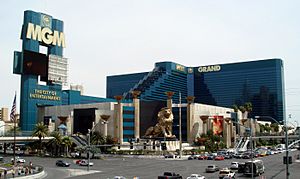

The economy of Nevada is tied to tourism (especially entertainment and gambling related), mining, and cattle ranching. Nevada's industrial outputs are tourism, entertainment, mining, machinery, printing and publishing, food processing, and electric equipment. The Bureau of Economic Analysis estimates Nevada's total state product in 2018 was $170 billion. The state's per capita personal income in 2020 was $53,635, ranking 31st in the nation. Nevada's state debt in 2012 was calculated to be $7.5 billion, or $3,100 per taxpayer. As of May 2021, the state's unemployment rate was 7.8%.
Mining
In portions of the state outside of the Las Vegas and Reno metropolitan areas mining plays a major economic role. By value, gold is by far the most important mineral mined. In 2022, 4,040,000 troy ounces (126 t) of gold worth $7.3 billion were mined in Nevada, and the state accounted for 4% of world gold production. Other minerals mined in Nevada include construction aggregates, copper, gypsum, diatomite and lithium. Despite its rich deposits, the cost of mining in Nevada is generally high, and output is very sensitive to world commodity prices.
Cattle ranching
Cattle ranching is a major economic activity in rural Nevada. Nevada's agricultural outputs are cattle, hay, alfalfa, dairy products, onions, and potatoes. As of January 1, 2006, there were an estimated 500,000 head of cattle and 70,000 head of sheep in Nevada. Most of these animals forage on rangeland in the summer, with supplemental feed in the winter. Calves are generally shipped to out-of-state feedlots in the fall to be fattened for the market. Over 90% of Nevada's 484,000 acres (196,000 ha) of cropland is used to grow hay, mostly alfalfa, for livestock feed. This livestock is usually used for food.
Largest employers
The largest employers in the state, as of the first fiscal quarter of 2011, are the following, according to the Nevada Department of Employment, Training and Rehabilitation:
| Rank | Employer |
|---|---|
| 1 | Clark County School District |
| 2 | Washoe County School District |
| 3 | Clark County |
| 4 | Wynn Las Vegas |
| 5 | Bellagio LLC |
| 6 | MGM Grand Hotel/Casino |
| 7 | Aria Resort & Casino LLC |
| 8 | Mandalay Bay Resort and Casino |
| 9 | Las Vegas Metropolitan Police Department |
| 10 | Caesars Palace |
| 11 | University of Nevada, Las Vegas |
| 12 | The Venetian Casino Resort |
| 13 | The Cosmopolitan of Las Vegas |
| 14 | The Mirage Casino-Hotel |
| 15 | University of Nevada, Reno |
| 16 | University Medical Center of Southern Nevada |
| 17 | The Palazzo Casino Resort |
| 18 | Flamingo Las Vegas Operating Company LLC |
| 19 | Encore Las Vegas |
| 20 | Luxor Las Vegas |
Infrastructure
Transportation
Amtrak's California Zephyr train uses the Union Pacific's original transcontinental railroad line in daily service from Chicago to Emeryville, California, serving Elko, Winnemucca, and Reno. Las Vegas has had no passenger train service since Amtrak's Desert Wind was discontinued in 1997. Amtrak Thruway buses provide connecting service from Las Vegas to trains at Needles, California, Los Angeles, and Bakersfield, California; and from Stateline, Nevada, to Sacramento, California. There have been a number of proposals to re-introduce service to either Los Angeles or Southern California.
The Union Pacific Railroad has some railroads in the north and south of Nevada. Greyhound Lines provide some bus service to the state.
Interstate 15 (I-15) passes through the southern tip of the state, serving Las Vegas and other communities. I-215 and I-515 also serve the Las Vegas metropolitan area. I-80 crosses through the northern part of Nevada, roughly following the path of the Humboldt River from Utah in the east and the Truckee River westward through Reno into California. It has a spur route, I-580. Nevada also is served by several U.S. highways: US 6, US 50, US 93, US 95 and US 395. There are also 189 Nevada state routes. Many of Nevada's counties have a system of county routes as well, though many are not signed or paved in rural areas. Nevada is one of a few states in the U.S. that do not have a continuous interstate highway linking its two major population centers – the road connection between the Las Vegas and Reno areas is a combination of several different Interstate and U.S. highways. The Interstate 11 proposed routing may eventually remedy this.
The state is one of just a few in the country to allow semi-trailer trucks with three trailers – what might be called a "road train" in Australia. But American versions are usually smaller, in part because they must ascend and descend some fairly steep mountain passes.
RTC Transit is the public transit system in the Las Vegas metropolitan area. The agency is the largest transit agency in the state and operates a network of bus service across the Las Vegas Valley, including the use of The Deuce, double-decker buses, on the Las Vegas Strip and several outlying routes. RTC RIDE operates a system of local transit bus service throughout the Reno-Sparks metropolitan area. Other transit systems in the state include Carson City's JAC. Most other counties in the state do not have public transportation at all.
Additionally, a 4-mile (6.4 km) monorail system provides public transportation in the Las Vegas area. The Las Vegas Monorail line services several casino properties and the Las Vegas Convention Center on the east side of the Las Vegas Strip, running near Paradise Road, with a possible future extension to Harry Reid International Airport. Several hotels also run their own monorail lines between each other, which are typically several blocks in length.
Harry Reid International Airport in Las Vegas is the busiest airport serving Nevada. The Reno-Tahoe International Airport (formerly known as the Reno Cannon International Airport) is the other major airport in the state.
Energy
Nevada has had a thriving solar energy sector. An independent study in 2013 concluded that solar users created a $36 million net benefit. However, in December 2015, the Public Utility Commission let the state's only power company, NV Energy, charge higher rates and fees to solar panel users, leading to an immediate collapse of rooftop solar panel use.
In December 1987, Congress amended the Nuclear Waste Policy Act to designate Yucca Mountain nuclear waste repository as the only site to be characterized as a permanent repository for all of the nation's highly radioactive waste.
Affordable housing
In 2018, the National Low Income Housing Coalition calculated the discrepancy between available affordable housing units and renters who earn below the poverty line. In Nevada, only 15 affordable rental homes are available per 100 extremely low income (ELI) households. The shortage extended to a deficit in supply of 71,358 affordable rental homes. This was the largest discrepancy of any state. The most notable catalyst for this shortage was the Great Recession and housing crisis of 2007 and 2008. Since then, housing prices have increased while demand has increased, and supply has struggled to match the increase in demand. In addition, low-income service workers were slowly being pushed out by an influx of tech professionals. In Nevada there is essentially a standard of six-figure income to affordably rent a single-family home. Considering the average salary in Nevada, $54,842 per year, this standard is on average, unaffordable. The disproportionate cost of housing compared to average salary has led to 112,872 renters to be paying more than half of their yearly income towards housing.
The definition of an affordable home is "one that a household can obtain for 30 percent or less of its annual income". So, there is clearly a long way to go in order to close the gap between housing prices and relative income in the state. Renters are looking for solutions to still be able to live in the state in a way that their income can support. As a result, single adults are being forced to split rent with other renters or move residences to farther outside metro areas. One solution being offered is to increase the supply of higher income positions within the state to make things more affordable. However, this would require Nevadans to retrain in new jobs or careers.
Education
Education in Nevada is achieved through public and private elementary, middle, and high schools, as well as colleges and universities.
A May 2015 educational reform law expanded school choice options to 450,000 Nevada students who are at up to 185% of the federal poverty level. Education savings accounts (ESAs) are enabled by the new law to help pay the tuition for private schools. Alternatively, families "can use funds in these accounts to also pay for textbooks and tutoring".
Approximately 86.9% of Nevada residents have attained at least a high school degree or equivalent, which is below the national average of 88.6%.
Public school districts
Public school districts in Nevada include:
- Carson City School District
- Churchill County School District
- Clark County School District, the fifth largest school district in the United States
- Douglas County School District
- Elko County School District
- Esmeralda County School District
- Eureka County School District
- Humboldt County School District
- Lander County School District
- Lincoln County School District
- Lyon County School District
- Mineral County School District
- Nye County School District
- Pershing County School District
- Storey County School District
- Washoe County School District
- White Pine County School District
Colleges and universities
- Nevada System of Higher Education
- University of Nevada, Las Vegas (UNLV)
- University of Nevada, Reno (UNR)
- Nevada State University (NSU)
- Truckee Meadows Community College (TMCC)
- Great Basin College
- College of Southern Nevada (CSN)
- Western Nevada College (WNC)
- Sierra Nevada College
- Touro University Nevada
- Roseman University of Health Sciences
Research institutes
- Desert Research Institute
The Nevada Aerospace Hall of Fame provides educational resources and promotes the aerospace and aviation history of the state.
Culture
Entertainment and tourism
Resort areas like Las Vegas, Reno, Lake Tahoe, and Laughlin attract visitors from around the nation and world. In fiscal year 2022 Nevada casinos (not counting those with annual revenue under a million dollars) brought in US$10.7 billion in gaming revenue and another US$15.7 billion in non-gaming revenue.
Nevada has by far the most hotel rooms per capita in the United States. According to the American Hotel and Lodging Association, there were 187,301 rooms in 584 hotels (of 15 or more rooms). The state is ranked just below California, Texas, Florida, and New York in the total number of rooms, but those states have much larger populations. Nevada has one hotel room for every 14 residents, far above the national average of one hotel room per 67 residents.
Sports
The Las Vegas Valley is home to the Vegas Golden Knights of the National Hockey League who began to play in the 2017–18 NHL season at T-Mobile Arena on the Las Vegas Strip in Paradise, the Las Vegas Raiders of the National Football League who began play at Allegiant Stadium in Paradise in 2020 after moving from Oakland, California, and the Las Vegas Aces of the WNBA who began playing in 2018 at Mandalay Bay Events Center after relocating from San Antonio. The Oakland Athletics of Major League Baseball plan to move to Las Vegas by 2027.
Nevada takes pride in college sports, most notably its college football. College teams in the state include the Nevada Wolf Pack (representing the University of Nevada, Reno) and the UNLV Rebels (representing the University of Nevada, Las Vegas), both in the Mountain West Conference (MW).
UNLV is most remembered for its men's basketball program, which experienced its height of supremacy in the late 1980s and early 1990s. Coached by Jerry Tarkanian, the Runnin' Rebels became one of the most elite programs in the country. In 1990, UNLV won the Men's Division I Championship by defeating Duke 103–73, which set tournament records for most points scored by a team and largest margin of victory in the national title game.
In 1991, UNLV finished the regular season undefeated, a feat that would not be matched in Division I men's basketball for more than 20 years. Forward Larry Johnson won several awards, including the Naismith Award. UNLV reached the Final Four yet again, but lost their national semifinal against Duke 79–77. The Runnin' Rebels were the Associated Press pre-season No. 1 back to back (1989–90, 1990–91). North Carolina is the only other team to accomplish that (2007–08, 2008–09).
The state's involvement in major-college sports is not limited to its local schools. In the 21st century, the Las Vegas area has become a significant regional center for college basketball conference tournaments. The MW, West Coast Conference, and Western Athletic Conference all hold their men's and women's tournaments in the area, and the Pac-12 holds its men's tournament there as well. The Big Sky Conference, after decades of holding its men's and women's conference tournaments at campus sites, began holding both tournaments in Reno in 2016.
Las Vegas has hosted several professional boxing matches, most recently at the MGM Grand Garden Arena with bouts such as Mike Tyson vs. Evander Holyfield, Evander Holyfield vs. Mike Tyson II, Oscar De La Hoya vs. Floyd Mayweather and Oscar De La Hoya vs. Manny Pacquiao and at the newer T-Mobile Arena with Canelo Álvarez vs. Amir Khan.
Along with significant rises in popularity in mixed martial arts (MMA), a number of fight leagues such as the UFC have taken interest in Las Vegas as a primary event location due to the number of suitable host venues. The Mandalay Bay Events Center and MGM Grand Garden Arena are among some of the more popular venues for fighting events such as MMA and have hosted several UFC and other MMA title fights. The city has held the most UFC events with 86 events.
The state is also home to the Las Vegas Motor Speedway, which hosts NASCAR's Pennzoil 400 and South Point 400. Two venues in the immediate Las Vegas area host major annual events in rodeo. The Thomas & Mack Center, built for UNLV men's basketball, hosts the National Finals Rodeo. The PBR World Finals, operated by the bull riding-only Professional Bull Riders, was also held at the Thomas & Mack Center before moving to T-Mobile Arena in 2016.
The state is also home to famous tennis player, Andre Agassi, and current baseball superstar Bryce Harper.
List of teams
Major professional teams
| Team | Sport | League | Venue (capacity) | Established | Titles |
|---|---|---|---|---|---|
| Las Vegas Athletics | Baseball | MLB | New Las Vegas Stadium (33,000) | 2025 or 2028 | 9 |
| Las Vegas Raiders | Football | NFL | Allegiant Stadium (65,000) | 2020 | 3 |
| Vegas Golden Knights | Ice hockey | NHL | T-Mobile Arena (17,500) | 2017 | 1 |
| Las Vegas Aces | Women's basketball | WNBA | Michelob Ultra Arena (12,000) | 2018 | 2 |
Minor professional teams
| Team | Sport | League | Venue (capacity) | Established | Titles |
|---|---|---|---|---|---|
| Las Vegas Aviators | Baseball | MiLB (AAA–PCL) | Las Vegas Ballpark (10,000) | 1983 | 2 |
| Reno Aces | Greater Nevada Field (9,013) | 2009 | 2 | ||
| NBA G League Ignite | Basketball | NBAGL | Dollar Loan Center (5,567) | 2020 | 0 |
| Las Vegas Royals | ABA | 0 | |||
| Vegas Ballers | TBL | Tarkanian Basketball Center (N/A) | 0 | ||
| Henderson Silver Knights | Ice hockey | AHL | Dollar Loan Center (5,567) | 2020 | 0 |
| Las Vegas Lights FC | Soccer | USLC | Cashman Field (9,334) | 2018 | 0 |
| Nevada Storm | Women's football | WFA | Damonte Ranch High School (N/A) Fernley High School (N/A) Galena High School (N/A) |
2008 | 0 |
| Sin City Trojans | Desert Pines High School (N/A) | 0 | |||
| Vegas Knight Hawks | Indoor football | IFL | Dollar Loan Center (6,019) | 2021 | 0 |
| Las Vegas Desert Dogs | Box lacrosse | NLL | Michelob Ultra Arena (12,000) | 0 |
Amateur teams
| Team | Sport | League | Venue (capacity) | Established | Titles |
|---|---|---|---|---|---|
| Reno Ice Raiders | Ice hockey | MWHL | Reno Ice | 2015 | 0 |
| Vegas Jesters | City National Arena (600) | 2012 | 0 | ||
| Las Vegas Thunderbirds | USPHL | 2019 | 0 | ||
| Las Vegas Legends | Soccer | NPSL | Peter Johann Memorial Field (2,500) | 2021 | 0 |
| Nevada Coyotes FC | UPSL | Rio Vista Sports Complex (N/A) | 2016 | 0 |
College teams
| School | Team | League | Division | Conference |
|---|---|---|---|---|
| University of Nevada, Las Vegas (UNLV) | UNLV Rebels | NCAA | NCAA Division I | Mountain West |
| University of Nevada, Reno (UNR) | Nevada Wolf Pack | |||
| College of Southern Nevada (CSN) | CSN Coyotes | NJCAA | NJCAA Division I | Scenic West |
| Western Nevada College (WNC) | WNC Wildcats |
Military
Several United States Navy ships have been named USS Nevada in honor of the state. They include:
- USS Nevada (1865)
- USS Nevada (BM-8)
- USS Nevada (BB-36)
- USS Nevada (SSBN-733)
Area 51 is located near Groom Lake, a dry salt lake bed.
The military bases host a number of activities including the Joint Unmanned Aerial Systems Center of Excellence, the Naval Strike and Air Warfare Center, Nevada Test and Training Range, Red Flag, the U.S. Air Force Thunderbirds, the United States Air Force Warfare Center, the United States Air Force Weapons School, and the United States Navy Fighter Weapons School.
See also
 In Spanish: Nevada para niños
In Spanish: Nevada para niños



